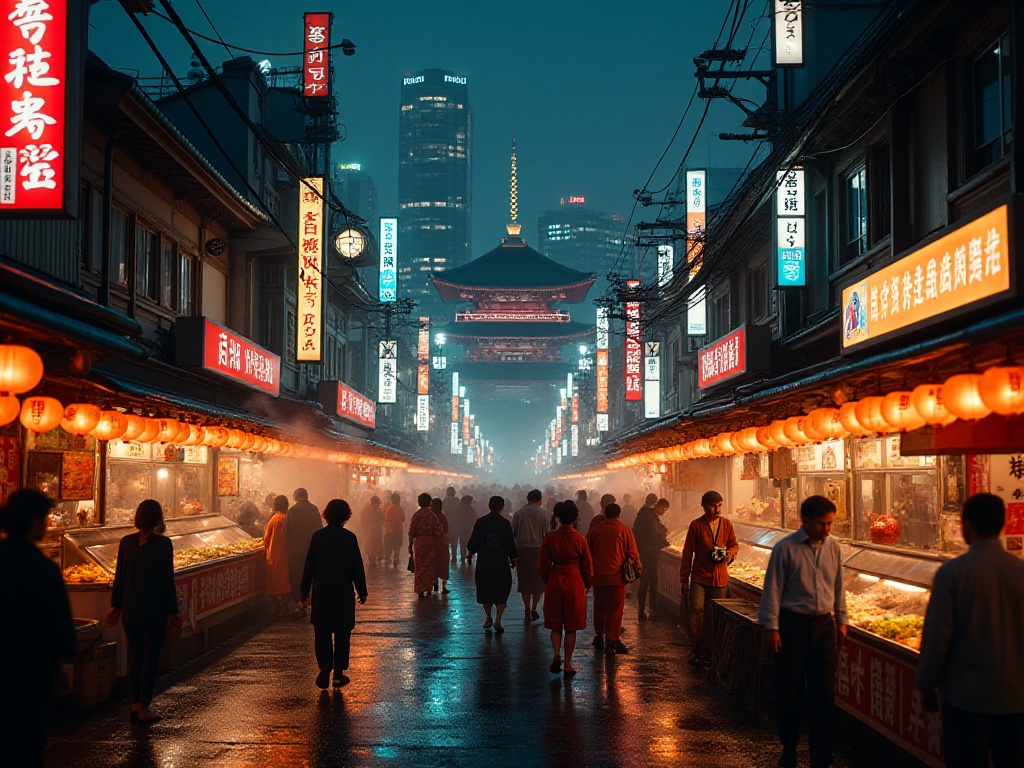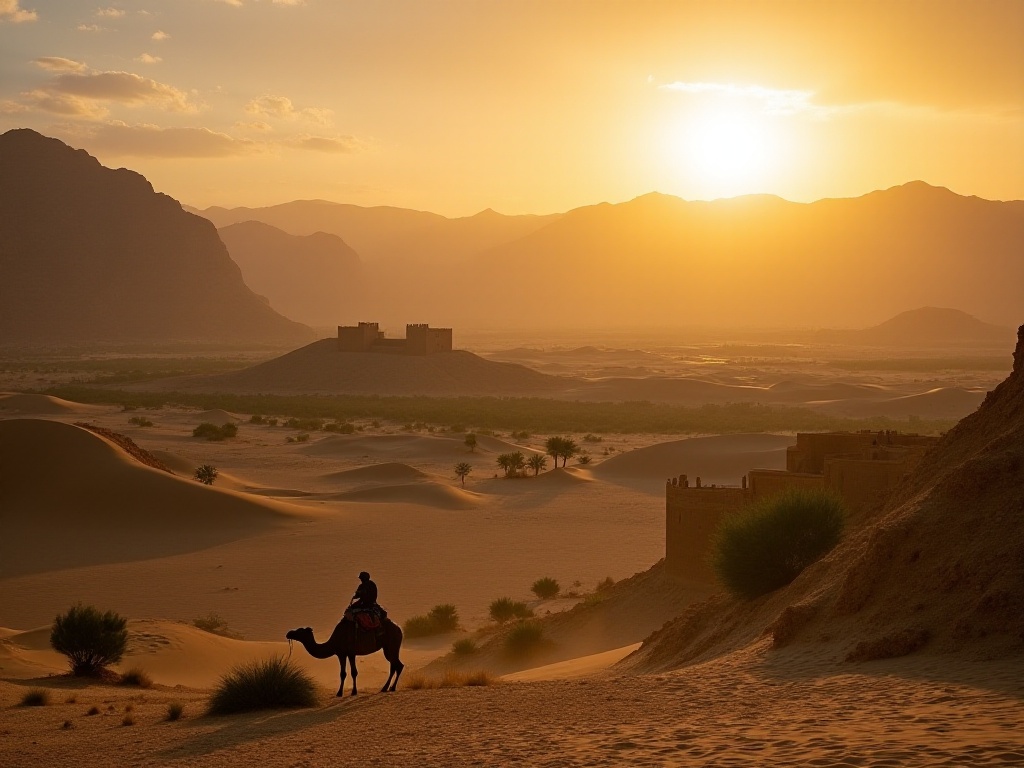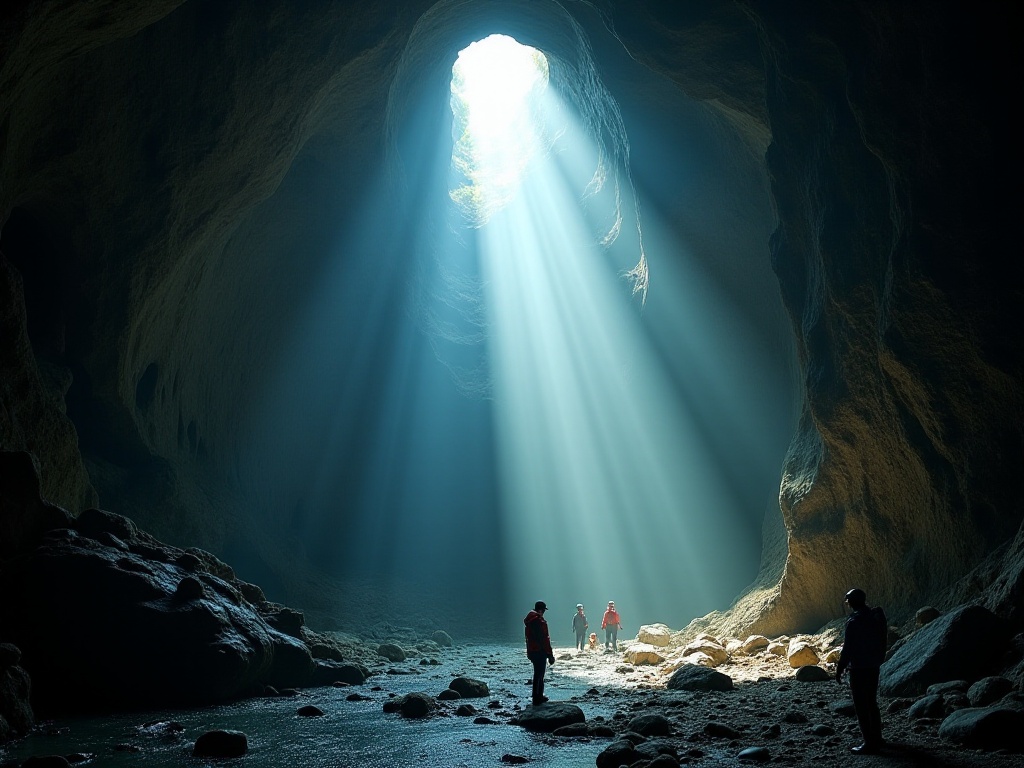First Impressions of Nepal
As a backpacker, my first impression of Nepal was absolutely stunning! The moment I looked down at the Kathmandu Valley from the airplane, I was deeply drawn to this mysterious country. Although Kathmandu Airport is small, the bustling crowd - including trekkers from various countries with their bags, local women in colorful saris, and lamas in robes - immediately gave me a sense of this place's unique cultural atmosphere.
Outside the airport, taxi drivers enthusiastically waved at me, calling out in broken Chinese: "Boss, going to Thamel?" Thamel is a backpacker's paradise, filled with countless specialty shops, restaurants, and guesthouses. Walking through the alleys of Thamel, colorful prayer flags flutter in the wind, curry aromas waft from the shops, and street vendors enthusiastically sell Nepalese handicrafts.
On my first night, I stayed at a hostel called "Himalayan Dream." The owner was a talkative Nepali who told me many stories about the Himalayas. Through the hostel window, I saw distant mountains bathed in golden sunset light, with circling vultures occasionally passing overhead - all of which made me eager to start my trekking journey.
Trekking Seasons
In Nepal, choosing the right time for trekking is crucial. Based on multiple trekking experiences, I've compiled a detailed seasonal guide. October to May of the following year is the best trekking season, but each month has its characteristics.
October-November is the ideal trekking period. The weather is particularly favorable, with high rates of clear days, fresh air, and visibility so good it could make you cry! Best of all, you can see rhododendrons blooming all over the mountains in pink, white, and red - absolutely stunning. Temperature differences between day and night are significant, with daytime temperatures between 15-20°C and nighttime possibly dropping below 0°C, but these temperatures are perfect for trekking.
December-February is winter, and while temperatures are indeed lower, there are fewer tourists and cheaper accommodations. Winter snow mountain scenery is particularly spectacular, with the snow-covered Himalayas taking your breath away. However, note that some passes may be closed due to snow accumulation.
March-May is spring trekking season, when you can see rhododendrons and various wildflowers covering the mountains. The weather gradually warms up, but occasional spring rains require rain preparation. This season isn't too crowded and is a good choice.
June-September is the rainy season and low season for trekking. However, the rainy season has its advantages: the scenery is particularly lush, waterfalls are magnificent, and prices are cheap, suitable for budget backpackers. But be mindful of mosquitoes and slippery conditions, as trails can be muddy.
Classic Routes
ABC Trek
The Annapurna Base Camp trek is absolutely my No.1! This route is about 230 kilometers long, generally taking 15-20 days to complete, but trust me, every day is worth it!
On my first ABC trek, I chose the clockwise direction, starting from Besisahar. At the beginning, the altitude was only around 1000 meters, surrounded by terraced fields with golden rice paddies gleaming in the sunlight. Local farmers would smile and say "Namaste," while children would curiously run behind you.
As the altitude increases, the scenery changes dramatically. Around 2000 meters, you pass through typical Nepalese mountain villages like Chame and Pisang. The houses in these villages are built of stone, with dried corn and firewood piled on the roofs. Staying in teahouses at night, you can hear the laughter of trekkers from various countries in neighboring rooms.
Above 3000 meters, vegetation becomes sparse, replaced by towering snow mountains. Crossing Thorung La pass (5416m), the feeling of standing in the clouds is indescribable! The Annapurna massif stands majestically in the distance, while nearby glaciers sparkle in the sunlight.
The most exciting moment is reaching Annapurna Base Camp (4130m). In the early morning, when the first rays of sunlight hit Annapurna South, the entire snow mountain turns pink - a natural phenomenon called "red wall" that you'll never forget.
EBC Journey
The Everest Base Camp trek is truly an irresistible challenge! This route typically takes 12-14 days, starting from Lukla Airport (2860m) and ascending to Everest Base Camp at 5364m.
The flight from Kathmandu to Lukla is a thrilling experience. The small plane weaves between mountains before landing at one of the world's most dangerous airports. The first time I saw that terrifyingly short runway, my heart was in my throat!
From Lukla, the first stop is usually Namche Bazaar (3440m). This town, known as the "Sherpa Capital," is built into the mountainside, with houses stacked like a huge outdoor amphitheater. Here you can buy all kinds of trekking equipment and taste authentic Sherpa butter tea.
Continuing upward, you pass the famous Tengboche Monastery (3867m). This Tibetan Buddhist monastery, backed by Ama Dablam (6812m), is one of the most beautiful sights along the entire trek. If you're lucky, you might see lamas performing morning prayers.
Further up, vegetation becomes increasingly scarce, replaced by bare rocks and glaciers. After reaching Gorak Shep (5164m), you're just one step away from Everest Base Camp! The first time I saw Everest, I almost cried with excitement. Although you can't see Everest's summit from base camp, just feeling the magnificent presence of the world's highest peak is enough.
On the EBC route, I've met all kinds of interesting people. There was an elderly British lady trekking in memory of a deceased friend, professional climbers preparing to challenge Everest, and ordinary trekkers like me just wanting to complete their bucket list. Though we came from different countries and spoke different languages, here we were united by the same goal.
Equipment Recommendations
Essential Checklist
When it comes to trekking equipment, it's really a topic that makes people anxious. As someone who has experienced multiple high-altitude treks, I deeply understand one principle: saving money on equipment will only hurt yourself in the end.
Hiking boots are absolutely the most important equipment, no exception! On my first trip to Nepal, I bought a pair of 500 yuan boots to save money, but the sole came off halfway through - absolutely tragic. Later, I spent 1800 yuan on waterproof, breathable hiking boots in Kathmandu, and the difference was immediate. I suggest everyone invest in hiking boots - waterproof boots in the 1500-2000 yuan range are the basic choice.
Warm clothing is also particularly important. I usually prepare three layers: a moisture-wicking base layer, fleece middle layer, and down jacket or hardshell outer layer. These three layers can handle temperature differences from -15°C to 15°C. A good down jacket costs around 1000 yuan, and a hardshell jacket is about the same price.
Backpack selection is also crucial. I use a 60-liter backpack, which is just right for all equipment. The backpack must have a rain cover and a comfortable carrying system, as you'll be with it for at least two weeks. A good trekking pack costs between 800-1200 yuan.
Other essential equipment includes: - Warm hat and gloves (about 200 yuan) - Buff/neck gaiter (about 50 yuan) - Trekking poles (200-400 yuan) - Sleeping bag (-15°C sleeping bag about 1000 yuan) - Headlamp (100-200 yuan) - Insulated water bottle (about 200 yuan) - Sunscreen (SPF50+) - Basic medical kit

Rental Guide
If buying equipment feels too pressured, renting in Kathmandu is a good option. Thamel has over 200 equipment rental shops, with fierce competition and reasonable prices.
A -15°C sleeping bag rental costs about 50-80 yuan per day, a 60L backpack is 30-50 yuan, and trekking poles are 20-30 yuan per day. If you rent equipment for two weeks, you can keep equipment expenses under 2000 yuan.
When renting equipment, note several points: 1. Carefully check equipment completeness and damage 2. Better to sign written agreements with shops 3. Prices can be negotiated, usually around 30% off 4. Choose reputable larger shops, small shops might give you damaged equipment
Budget Planning

Transportation Costs
Airfare from China to Kathmandu varies greatly - low season tickets can be found for 2000 yuan, while peak season might cost 4000 yuan. I recommend booking 2-3 months in advance to find suitable prices.
Within Nepal, a one-way small aircraft ticket from Kathmandu to Lukla costs about 1000 yuan. These flights often cancel due to weather, so it's best to leave some flexible time. If choosing buses, prices are much cheaper - Kathmandu to Besisahar is only about 50 yuan, but it's a 6-8 hour mountain road journey with poor road conditions.
In trekking areas, you mainly rely on walking. Some places have jeeps or minibuses, which aren't expensive, usually just dozens of yuan. However, note that in some remote areas, vehicles are infrequent and you might need to wait a long time.
Accommodation Expenses
In Nepal, accommodation is one of the most economical expenses. Teahouses along the way are not only affordable but also let you experience the most authentic Nepalese life.
In teahouses below 3000m, lodging generally costs 30-50 yuan per night. Though rooms are simple, they're usually clean. However, remember that prices increase with altitude. Near base camp, a night might cost 100-150 yuan.
Teahouses have an unwritten rule: if you eat meals there, lodging is cheaper, sometimes even free. So smart backpackers usually choose to eat at their lodging teahouse.
Moreover, teahouses are the best places to meet trekkers from various countries. In the evening, everyone gathers around the stove, drinking butter tea and sharing the day's trekking experiences - it's really wonderful!

Food Recommendations
Local Cuisine
Speaking of Nepalese food, Dal Bhat is absolutely trekkers' favorite! This traditional dish includes curry lentil soup, rice, curry vegetables, and pickles - nutritionally balanced and energy-rich. Best of all, many teahouses offer free Dal Bhat refills.
At lower altitudes, Dal Bhat costs about 40 yuan, but prices rise with altitude - near base camp it might cost 60 yuan. However, considering the refills, this price is still very reasonable.
For breakfast, I usually choose Gurung Bread with butter tea, or Western breakfast like eggs and toast. Lunch is usually simple to avoid affecting trekking - cookies or energy bars. Dinner must be nutritious to replenish energy.
Interestingly, Western food becomes more common at higher altitudes. You can find pasta, pizza, even apple pie. Though the taste might differ from authentic versions, having these foods at high altitude is already quite good.

Water Safety
At high altitudes, adequate water intake is extremely important. You need to drink at least 3-4 liters daily to prevent altitude sickness. However, bottled water isn't cheap. At low altitudes, mineral water costs about 5 yuan, but near base camp, it might cost 30 yuan per bottle.
So I strongly recommend bringing a water filter bottle. There are many reliable water filter bottle brands, priced between 200-400 yuan. With a filter bottle, you can directly drink stream water or teahouse tap water - both eco-friendly and economical.
However, before using a filter bottle, better ask teahouse owners about the water source. Some places' water sources might be contaminated, in which case bottled water is safer.

Altitude Sickness Prevention
Altitude sickness is an issue every trekker must face. I remember my first time at EBC, staying in Namche, experiencing severe altitude sickness. Splitting headache, couldn't sleep all night - that suffering is really memorable.
Looking back, it was completely due to lack of preparation. Ascending too quickly without giving the body enough time to adapt. So I recommend not ascending more than 500 meters per day from 3000 meters altitude. And must follow the "climb high, sleep low" principle - you can go higher during the day but return to lower altitude for rest at night.
Besides controlling ascent speed, there are some practical tips for preventing altitude sickness: 1. Start taking Rhodiola a week in advance to help body adapt to high altitude 2. Drink plenty of water, get adequate rest 3. Avoid strenuous exercise, maintain steady pace 4. Eat light meals at night to avoid burdening the body 5. Bring common medications like ibuprofen (pain relief), acetazolamide (altitude sickness prevention)
If experiencing severe altitude sickness symptoms like severe headache, vomiting, serious shortness of breath, must descend immediately. Remember, no scenery is worth risking your life for.
Practical Tips
Regarding insurance, I recommend definitely buying outdoor insurance that includes high-altitude rescue. Though expensive, about 500-1000 yuan, it can really save your life in emergencies. I've seen trekkers rescued by helicopter due to altitude sickness - without insurance, helicopter costs alone would be tens of thousands of yuan.
Getting a Nepal visa is very simple - you can choose visa on arrival. 30-day visa costs 40 USD, remember to bring cash and passport photos. When getting visa on arrival at Kathmandu airport, recommend filling the form online in advance to save time.
Additionally, some practical tips: 1. Bring enough cash, high altitude areas generally don't have ATMs 2. Prepare a power bank, many teahouses charge for electricity 3. Buy a local SIM card for contact and internet 4. Bring small gifts for local children, like pencils and notebooks 5. Learn some simple Nepali phrases, like "Namaste" (hello), "Dhanyabad" (thank you)
Conclusion and Outlook
Every time I think about trekking in Nepal, I'm deeply moved. There, you not only see the world's most magnificent mountain views but also find inner peace. When you stand above 4000 meters, watching sunrise and sunset, listening to prayer flags fluttering in the wind, all troubles disappear.
Nepal isn't just a trekking paradise, but a place where you can rediscover yourself. There, you'll find you're stronger than imagined, meet interesting souls from around the world, and experience the purest joy.
Every time I return from Nepal, I feel different. Perhaps because there, we don't need pretenses, don't need to consider worldly gains and losses, just need to focus on the path ahead and enjoy the trekking process.
This magical land always welcomes every trekker who comes with dreams. Whether you want to challenge yourself or find inner peace, in Nepal, you can find your own answer.
Have you been trekking in Nepal? Or are you planning to go? Feel free to share your story or questions in the comments. If you found this article helpful, remember to save it - believe it will come in handy someday.








